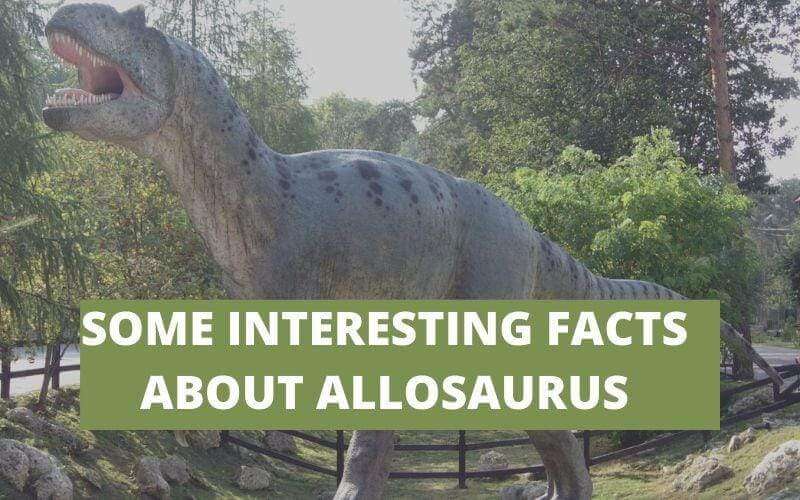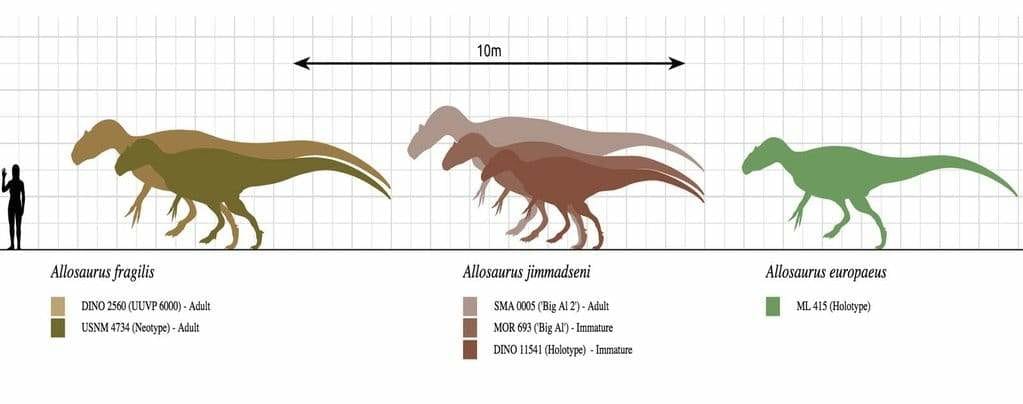Your Cart is Empty
Enjoy FREE Shipping on All Orders This Week! Shop Your Favorites Now!

Allosaurus is a genus of carnivorous theropod dinosaurs that lived in North America and Europe at the end of the Upper Jurassic.
Allosaurus resembles the smaller version of the Tyrannosaurus rex, the great large bipedal predator that the general public thinks of when talking about dinosaurs. Allosaurus, was not an actor in the Jurassic Park movie. However, it probably was more agile and faster than the T. rex, which gave it good skills to hunt its prey, it was even able to pounce on them. Allosaurus is the theropod dinosaur with the most fossils discovered, including some almost complete skeletons.
Its name is derived from the Greek Allos ( different ) and Saurus ( lizard ), the name Allosaurus means "different lizard".
Its name was given referring to its distinctive concave vertebrae upon its discovery.
Three species of allosaurs are known to date.
This massive carnivore from the Upper Jurassic (156-137 Ma) was 40 feet (12 meters ) long, 13 feet ( 4.60 meters ) high, and weighed two tons, making it the largest predator of its time. Above its eyes, there was a thin bony ridge, extending almost to the end of his muzzle. His skull was lightened by " skull windows ", which were actually large openings in the skull, to lighten and reduce the solid structure into a network of bone stems. The bones themselves articulated freely.

Allosaurus Size Comparison
Allosaurus lived in the vast and flood plains of what is now North America and Western Europe.
The presence of the same dinosaur in North America and Western Europe is not all that surprising since, in the Jurassic period, the Atlantic Ocean was just beginning to open and North America and Western Europe formed the same landmass, called Laurasia. It was, therefore, possible for Allosaurus to walk across these now separate continents. Remains discovered in Australia have been attributed to Allosaurus (Molnar, 1981), but it is thought to be an Allosauroid similar to Fukuiraptor.
Allosaurus had a large and powerful body, a long tail and long arms terminating in three sharp claws that he probably used to catch his prey. It stood on its two hind legs. The back of his skull was also narrow and his face was flat from the muzzle to the eyes.
At the time, it was the most common predator in the region and was at the top of the food chain, thanks in part to its jaw with 80 sharp teeth.
The allosaurus was a carnivore, feeding on the dinosaurs it hunted.
This fearsome predator was certainly the nightmare of all Ornithopods, Stegosaurids or Sauropods, like Lesothosaurus, Stegosaurus, young Diplodocus or young Brachiosaurus living near it, i.e. the main herbivorous dinosaurs of the time, without neglecting the smaller theropods, lizards and mammals. It is not excluded that it fed on carrion if it had the opportunity, like most of today's large predators, or even on prey stolen from the smallest theropods. In fact, one of its first names, Antrodemus "the nightmare dragon", reflected its hegemony very well.
There is evidence of Allosaurus' predation. For example, we found an Allosaurus caudal vertebra (UMNH 10781), which lacks part of the cross-sectional process. The bone shows that when the animal was alive, this part broke off, but Allosaurus did not die from this blow since it lived long enough afterward for part of the bone to heal around the wound. Carpenter & al. (2005) showed that this Allosaurus was in fact struck by the pointed tip of the tail of a Stegosaurus (called the thagomizer), breaking this vertebra, presumably during an attack on the Stegosaurus by the Allosaurus.
Numerous skeletons of Allosaurus have been discovered. However, there are only two complete Allosaurus species: A. fragilis (described in 1877) and probably A. europaeus (described in 2006). Some interesting specimens have been attributed to the species A. "jimmadseni", but incomplete taxonomic studies do not allow to be sure.
Among the individuals attributed to Allosaurus "jimmadseni" is a 13-feet ( 4-meters ) long juvenile. It was found with traces of fossilized skin, consisting of large scales of 2-3mm, over an area of 300mm2 (Pinegar et al., 2003).
A specimen nicknamed Dracula is also part of Allosaurus "jimmadseni". 30-feet 9 meters long and 70-75% complete, its skull has the advantage of not being deformed and of having been found in an anatomical connection, with its teeth still in position in the jaws. Approximately 70 teeth lined Allosaurus' mouth, but they are rarely found in place. On the one hand because during the animal's lifetime they fell out quite regularly (e.g. as a result of shocks or while feeding). On the other hand, because once the animal is dead, the teeth are no longer held by the gums, a soft organ that does not fossilize, so they end up being removed. Dracula thus presents a rare example of complete dentition in an anatomical position. Like many theropods, the teeth of Allosaurus were all curved backward, making it possible, for example, to bite the prey and prevent it from escaping. The dentition is zyphodont-like, i.e. the teeth are flattened laterally, their posterior and anterior edges are crenelated, like the blade of a knife.
Only one of Dracula's teeth is broken. Its discoverers explain it by the fact that its skeleton was found completely entangled with the skeleton of a stegosaurus, nicknamed Fantasia, and belonging to the species Stegosaurus mjosi. Scientists were like kids the Christmas morning and saw the last fight of an allosaurus against a stegosaurus, worthy of a Hollywood movie. All that can be said is that the quarry was a feeding area, that the stegosaurus and the allosaurus lived at the same time and probably became trapped in a kind of quicksand. The rapid burial and the sediment allowed the bones to remain in very good condition and anatomically connected. The skeletons of the dinosaurs Dracula and Fantasia were auctioned off in 2011 with a reserve price of $2.5 million.
A fossilized skeleton belonging to a male Allosaur was discovered fairly recently in Wyoming. It was named 'Big Al'. From this skeleton, Tim Haines' team (the team that made "Walking With Dinosaurs") has reconstructed the history of this Jurassic predator that lived more than 150 million years ago... The first program retraces the 15 years of Big Al's existence, 15 years of an incredible and formidable fight just for his survival. The second program retraces the colossal work of scientific investigation carried out by paleontologists to achieve the most real and reliable representation possible.